Making DIY potting soil is easy, and saves you money! In this post, I’ll talk about all the benefits, explain each ingredient, and give you seven of my favorite recipes. Plus I’ll show you exactly how to make your own, and store the leftovers for later.
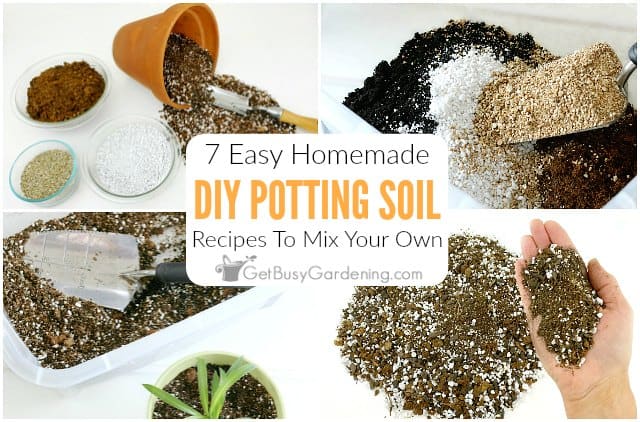
Many times, the biggest cost of gardening is buying soil. Well guess what, DIY potting soil is not only more cost effective than buying the commercial stuff, it’s also super simple to make!
No matter what type of plant you want to grow, indoors or outside, you’ll find the perfect homemade potting mix recipe below.
Once you learn how to make potting soil, you can be confident that you’re always using the best possible mix for every one of your plants. The best part is that you can easily modify any of my recipes to create your own version.
Benefits Of Making Potting Mix
Although bags of potting soil are available at retailers everywhere, there is no reason to purchase these mass-produced mixes. Making your own potting mix has several benefits…
- Cheaper than buying a premade mix – Commercially produced mixes are expensive to buy, so making your own will save you money. The ingredients you need are inexpensive, and you can use them in many different homemade potting mix recipes.
- It’s fun to mix your own – Making your own potting soil is easy and fun. If you have children, this is an excellent opportunity to involve them. Mixing tactile materials is the sort of messy fun that the young and young at heart will enjoy.
- You control the ingredients – Creating your own allows you to use high-quality, organic ingredients. Since you choose what goes into it, you can avoid the chemicals and additives commonly found in many commercial brands.
- Mix up as much or as little as you need – Making homemade potting mix allows you to prepare only enough for the intended purpose. When you buy the commercial stuff, you must purchase a standard volume.
- It’s fully customizable – Assembling your own mixes allows you to completely customize the formula. With a few key ingredients, it is possible to create potting soil for a wide variety of plant needs.
Homemade Potting Soil Ingredients
Below I will give you a quick description of the basic potting soil ingredients used in these recipes. That way, you’ll understand what each one is for.
You should have no problem finding these organic ingredients at any garden center, home improvement store, or by ordering them online.
Peat Moss
Every potting mix recipe starts with a base ingredient, and peat moss is a popular one. It provides aeration and water retention.
It’s important to note that peat moss is acidic. So, unless you’re growing acidic-loving plants, you’ll need to add 1 tablespoon of garden lime to every gallon of peat to even out the pH to a neutral 7.
Also, peat is usually packed dry (because it’s much more lightweight that way), so be sure to pre-moisten it before using it for making potting soil.
Coco Coir
Another popular base ingredient, coco coir is a more sustainable alternative to peat moss. It is a bi-product of coconut processing, which is why it’s more sustainable.
It’s also neutral, so you don’t have to worry about acidity, and there’s no need to add any lime to it.
Coco coir usually comes in a compacted block, so you’ll need to break it apart and moisten it before use. Once moistened, it will expand a little too. So be sure to add water before measuring it for your recipe.
Compost
A natural way to add essential nutrition to your DIY potting soil is to add compost. You can use homemade compost, mushroom compost, decomposed manure, or worm castings.
However, if you do choose to use your own, be sure it has been heated properly. Otherwise it could contain bugs and weed seeds, and you don’t want to add those to your mix.
Perlite
If you ever wondered “what is the white stuff in potting soil?”, perlite is the answer. This is very commonly added to potting mixes to increase drainage, and prevent soil compaction.
Perlite also reduces the density of the mix, making it lighter, and easier to handle. If you can’t find it for sale anywhere, then you can substitute with pumice instead.
Coarse Sand
Many types of plants need a fast draining soil mix, and that is where sand comes in. Not only does it help to increase drainage, it also keeps the mix workable.
Just be sure that you buy coarse sand, and not the super fine stuff. If it’s too fine, it can cause soil compaction, and hold too much water. A few excellent alternatives to sand are either turface or poultry grit.
Vermiculite
The biggest benefit of adding vermiculite into your DIY potting mix is to help the soil retain moisture, but it also reduces soil compaction.
It should be present in most soil mixes, especially if you tend to forget to water your plants. The exceptions are mixes used for succulents or cactus plants.
Gypsum
This natural soil amendment keeps the mix porous and workable, and is especially good for breaking up hard or heavy soils.
Garden gypsum also provides calcium, which is a minor nutrient necessary for many fruiting and flowering plants, like vegetables.
Blood Meal
Another natural additive often found in many commercial mixes is blood meal. This is an organic source of nitrogen, which promotes healthy, rich green foliage growth.
It’s a wonderful soil amendment for annuals and perennials, and works great for growing prolific leafy vegetables too.
Garden Lime
Also referred to as crushed limestone, garden lime is a natural amendment that raises the ph, neutralizing acidic soils.
You should add it to any homemade potting mix recipe where you use peat moss. Unless of course it’s for acidic soil loving plants!
DIY Potting Soil Recipes
Below you will find a round-up of several different homemade potting soil recipes. Choose the one that best suits the needs of each of the plants you want to grow.
1. Cactus & Succulent Soil
This mix provides dessert plants with structure and stability, as well as the important drainage that they need.
You can use this recipe for all types of succulents, both indoors or outdoors. Find the detailed instructions for making it here.
- 3 parts potting soil
- 2 parts coarse sand (use 3 parts for cactus plants)
- 1 part perlite (or pumice)
Though this can also work for cacti, they like an even faster draining mix. So try either my cactus soil recipe, or my gritty mix for even better drainage.
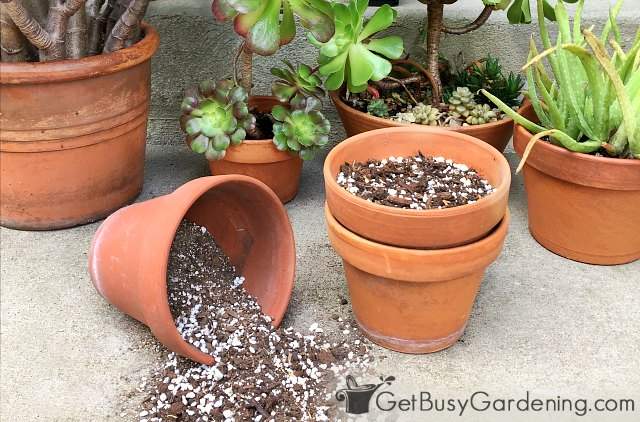
2. Vegetables & Herbs Mix
This potting soil recipe provides vegetables and herbs with everything they need in order to produce tons of yummy food for us. It should only be used for outdoor containers or garden beds.
- 2 parts peat moss or coco coir
- 3 parts compost, decomposed manure, or worm castings
- 1 part perlite
- 1 part coarse sand
- 1 part vermiculite
- 1/4 part garden gypsum
- 1 tablespoon garden lime per gallon of peat (optional)
3. Houseplant Potting Soil
With just a few simple ingredients, this lightweight and odorless DIY potting mix is perfect for all your indoor plant needs. Read the full tutorial for making houseplant soil here.
- 2 parts pre-moistened peat moss or coir
- 1 part perlite or pumice
- 1/4 – 1/2 part vermiculite
- 1 tablespoon ground limestone per gallon (if you use peat moss)
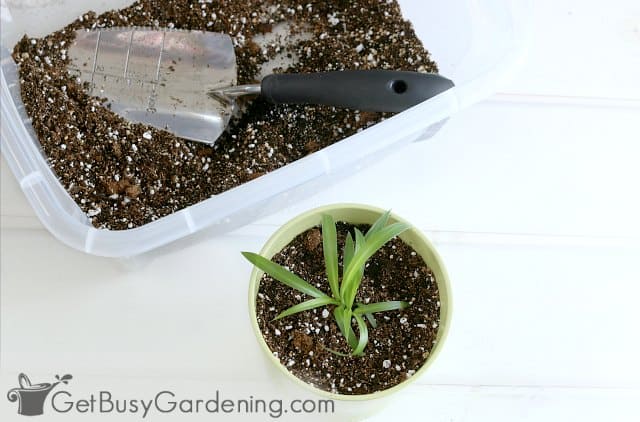
4. Basic Outdoor Container Potting Soil
This all-purpose outdoor container mix is nutrient-rich, and provides good water holding capacity for your summer pots and planters. Get the full instructions for how to make outdoor container soil here.
- 2 parts peat moss or coir (pre-moistened)
- 2 parts compost or composted manure
- 1 part perlite
- 1/4-1/2 parts vermiculite
- 1 tablespoon garden lime for each gallon of peat moss
5. Outdoor Soilless Potting Mix
This soilless potting mix recipe will provide your outdoor hanging plants with everything that they need to grow successfully.
It’s a lightweight and long-lasting media that is perfect for window boxes and hanging baskets.
- 2 parts peat moss (or coir)
- 2 parts vermiculite
- 1/4 part ground limestone
- 1/4 part super phosphate
- 1/2 part blood meal
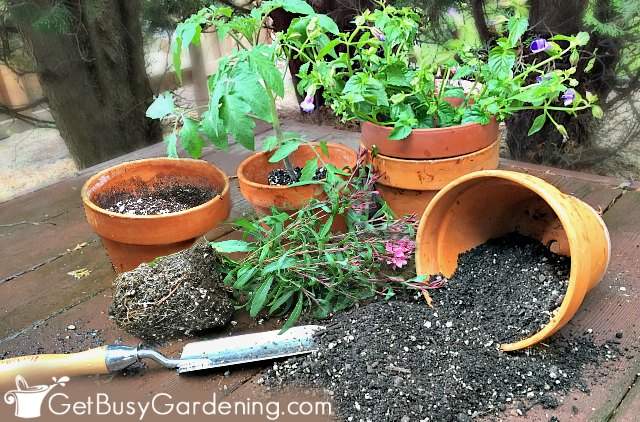
6. Acidic Potting Soil
This potting soil mix has a high percentage of peat moss, which is naturally acidic.
Use this recipe, without amending it with garden lime, to provide a medium that is perfect for plants that thrive in acidic conditions.
- 4 parts peat moss
- 2 parts compost or composted manure
- 1 part perlite
- 1/4 – 1/2 part vermiculite
7. Seed Starting Mix
Young seedlings are incredibly delicate, which is why they need a specialized medium to get the very best start.
This lightweight mix is fast-draining, while also providing good water retention. Learn exactly how to make it here.
- 8 parts (pre-moistened) coco coir or peat moss
- 1 part vermiculite
- 1 part perlite or pumice
- 1 tablespoon garden lime per gallon (if you use peat)

How To Mix Potting Soil
Making your homemade potting mix is simple. All you’ll need are the ingredients, and a few supplies that you should be able to find around your house.
Supplies Needed
- DIY potting soil ingredients
- Measuring container (your “part”)
- Shovel or trowel
- Garden tub, wheelbarrow, potting tray, or bucket
- Safety mask (so you don’t breath in the dust)
- Water
Don’t worry too much about the method of measurement you choose as a “part”. You can use a measuring cup, a soil scoop, or a one gallon bucket – whatever is most convenient for you.
The potting mix recipes are essentially ratios of materials. The parts are fulfilling the described rate of ingredients in these recipes.
Before getting started, be sure to always wear a safety mask while handling and mixing your own potting soil.
Once you gather all of your supplies, measure out each ingredient using your part. Then you can simply dump all of the ingredients into the mixing container.
Use a trowel or shovel to stir everything together until well mixed. If the ingredients are very dry, then add enough water to moisten them as you work.
Once it’s mixed up, you can use your DIY potting soil immediately, or store it for later.
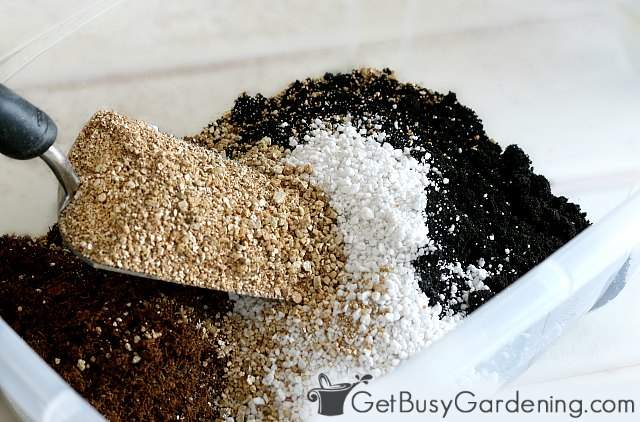
Storing Leftover Homemade Potting Mix
One of the biggest benefits of making your own potting soil is that you can mix as much or as little as you need at the time. But, if you would rather whip up a larger batch, or if you have leftovers, you can easily store it for later use.
Just make sure you store it in an air-tight container, so bugs can’t get into it. A five gallon bucket with a tight fitting lid is perfect.
Then you can simply place it on a shelf in your basement, garage, or shed. Be sure to mark each bucket with the type of homemade potting soil it contains, because they’ll pretty much all look the same once mixed.
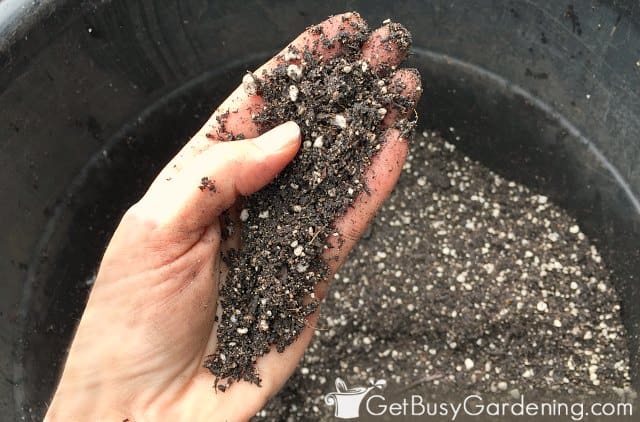
DIY Potting Soil FAQs
In this section, I’ll answer some of the most frequently asked questions about homemade potting soil. If you can’t find an answer to your question here, ask it in the comments below.
How long does potting soil last?
While there’s really no expiration date for homemade potting soil, some of the ingredients will start to degrade after a while. For best results, use it within six months.
If it’s stored any longer than that, you can add more nutrients to the mix to rejuvenate it. But be sure to discard old mixes that smell bad, or if you find bugs or mold growing in it.
What is the difference between potting soil and potting mix?
Many people use these two terms interchangeably, which totally is fine. Most of the time, there is no difference between the two terms.
But technically, “potting soil” usually means it contains actual soil (such as compost). Where the term “potting mix” is usually used to describe a medium that is soilless.
Can I mix garden soil and potting mix?
No, it’s never a good idea to add garden soil into any potting mix recipe. Garden soil contains bugs and pathogens that can wreak havoc in containers, and cause all kinds of problems.
However, if you’re making soil for your outdoor garden beds, then adding potting mix to it is not an issue.
Can you reuse potting soil?
No, I do not recommend ever reusing your potting soil, homemade or otherwise. Soil can harbor diseases and bugs, which can easily be spread from one plant to another when you reuse it. So it’s best to toss the used stuff into your compost bin.
Is it good to mix sand with potting soil?
It is good to mix sand with certain types of potting soil, but it depends on what type of plant you’ll use it for. Sand helps improve drainage, which if very important for plants that are susceptible to overwatering.
However, it also makes the soil dry out faster, which isn’t good for plants that need to stay consistently moist. So, only mix sand with your potting soil if you want it to dry out quickly.
Creating your own DIY potting soil is fun, easy, and saves you money. Plus you can customize the ingredients, and experiment with your own homemade recipes in order to find the perfect soil mix for every one of your plants.
More About Potting Soils
- How To Test Your Soil At Home Using A Soil Test Kit
- How To Prepare A Garden Bed For Planting Vegetables
- How To Fertilize A Vegetable Garden
- How To Choose The Best Money Tree Soil
Share your favorite DIY potting soil recipe in the comments below.
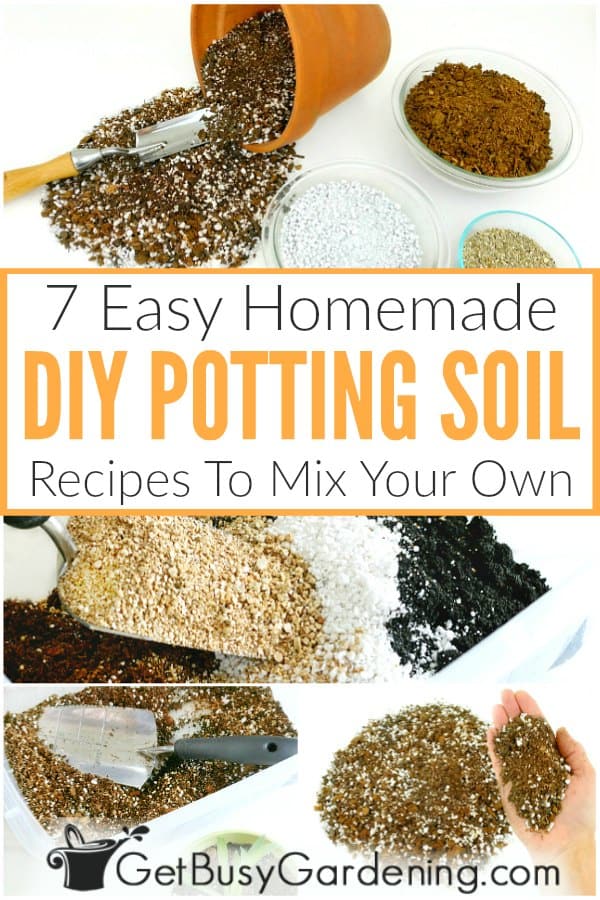
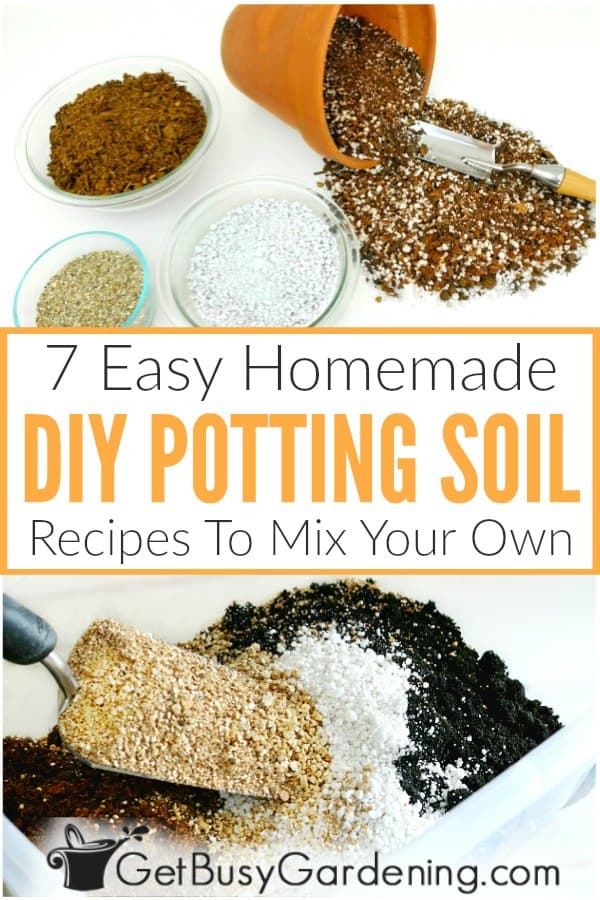
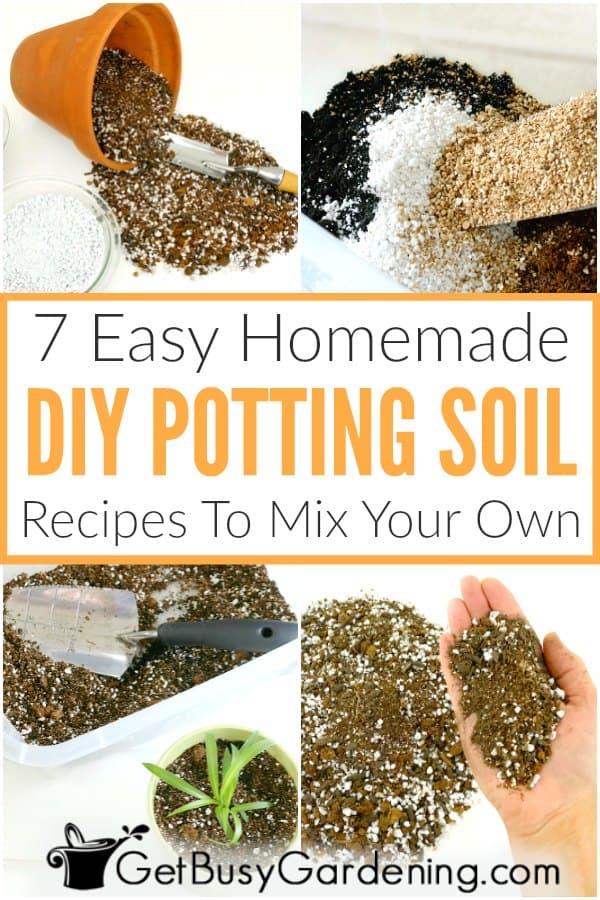

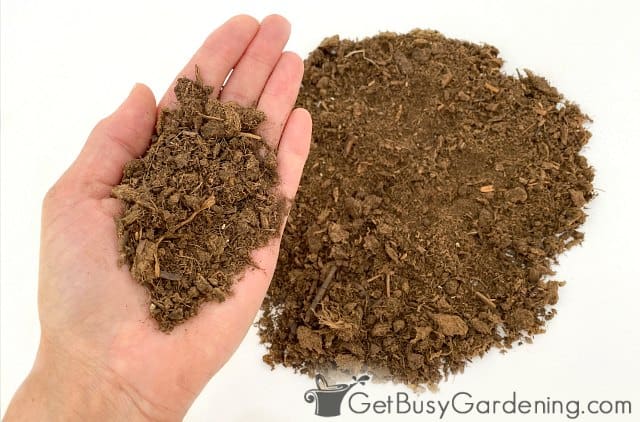
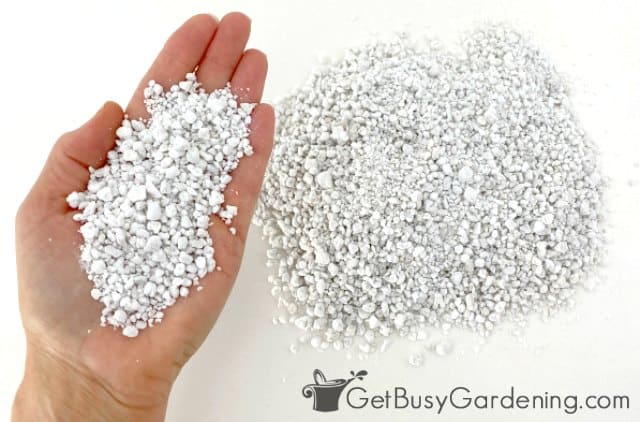
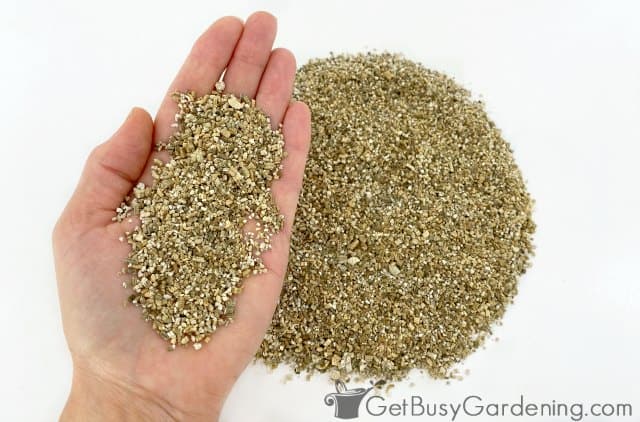

Melissa says
Could you please tell me what to add to your succulent soil mix for a Ponytail Palm, Fiddle Leaf Fig, Corn Plant and Monstera. I’m asking a lot but could really use your help! I’m new at house plant care and trying to use all the right soil mixes. Thanks so much!
Amy Andrychowicz says
You could use my succulent soil recipe for your ponytail palm, they like a fast-draining mix. My general houseplant soil mix recipe will work great for fiddle leaf fig, corn plant, and monstera.
Lion says
I’m looking at the recipe for vegetables and herbs, glancing at my wallet, looking at the recipe again.
It looks as though together, perlite and vermiculite add drainage, moisture retention, and what I’ll call fluffiness – and that those properties are also found in the combo of coconut coir and sand.
Is it possible to make an almost-as-good mix for veggies using just coconut coir, compost, coarse sand, and gypsum?
Amy Andrychowicz says
I wouldn’t skip the “fluffy” ingredients or the soil will likely be too heavy for your veggies, and it would probably become compacted.
JP says
Trying to figure out how this saves much if any money. Alot of ingredients to buy. The compost I can ger for free, the rest not so much and they all cost about the same as potting soil individually.
Amy Andrychowicz says
Right, but once you have all of the ingredients, you can make large batches of your own potting soils – which is usually cheaper than buying the pre-mixed bags.
Doug Powell says
Thanks for this great resource on potting soils. I am trying to put together a table of ratios of the various ingredients normally used, and I am confused by one point. For “cactus and succulent soil”, the first ingredient is “potting soil” and you link to an amazon shopping page. I had thought the idea was to mix your own from scratch. Is there another recipe on this web page I can use instead for that “store-bought” soil?
Secondly, you frequently mention the use of “garden lime”. I would like to know if this is only or pH adjustment. I make it a practice to measure pH in everything I do and only make pH adjustments when needed. I live on the Front Range of Colorado and the majority of our natural soils here are very alkaline. When I see, people routinely recommending lime, I think, “Oh, this person is from the East Coast or Upper Midwest and they don’t know our situation here.” In fact, in my 300 sq. ft. garden I had to add nearly 6 bales of peat moss just to lower the pH numbers two points down to the 6.0 to 7.0 range. So, if you’re recommending lime for pH reasons, what are your thoughts about skipping this step?
All the best, ~doug
Amy Andrychowicz says
You could try experimenting with my gritty soil mix for your succulents. As for the lime, yes, that is only needed for neutralizing the acidity if you use peat moss for making your potting soil – an only necessary if the plants you’re growing like alkaline or neutral soil. Your practice of measuring the pH and only adjusting it if necessary is the right approach.
Meggie Schultz says
What recipe would you recommend for a plumeria start ( 1 foot branch)?. Live in Minnesota and would like to grow plumerias. Winter under lights in winter and outside in summer. This is my first attempt at growing these plants, so any advice would be helpful
Amy Andrychowicz says
How fun, I love them and have had mine (in MN!) for over 20 years! I make my own potting soil mix using equal parts perlite, potting soil, and course sand. Here are a few articles that will give you all of the details you need…
Propagating Plumeria Cuttings In 5 Easy Steps
How To Overwinter Plumeria (Frangipani) Plants Indoors
How To Care For Plumeria Plants (Hawaiian Frangipani)
Dean Cuebas says
I see a discrepancy in your directions on how to make seed starting mix.
In number seven on the following page: https://getbusygardening.com/diy-potting-soil/
you say 1/4 tsp of garden lime per gallon.
On page: https://getbusygardening.com/diy-seed-starting-mix/
you say 1 tablespoon garden lime per gallon.
That is a factor of 12 difference between the two methods!
Please tell me which is the correct amount of garden lime per gallon.
Thank you for your time and consideration!
Regards,
Dean Cuebas PhD
Amy Andrychowicz says
Thanks for pointing out the discrepancy between the two soil recipes, I have corrected it on this one. It should be 1 tablespoon of garden lime per gallon, but you only need to add it if you use peat moss.
Duane C. Pollak says
Very informative, thank you. You don’t specifically mention fruits… would I use the recipe for Vegetables & Herbs? I’m currently specifically interested in Dwarf Cavendish Bananas, Mission & Violetta Figs & Dwarf Pomegranate.
Amy Andrychowicz says
Great question! It varies depending on the type of fruit you want to grow. All of the fruits you mention will do great in the vegetable/herb potting soil. They do prefer a slightly acidic soil, so skip adding the lime. If you ever grow citrus or berries, then use the acidic potting soil recipe instead.
Duane C. Pollak says
Thanks for your prompt response as well as the additional info for citrus and berries, as they are planned for next year. LOVE your site!
Amy Andrychowicz says
You’re welcome, and thank you! 🙂
Mike says
Great article Amy! I am happy to know I can find these items easily online. The instructions are easy to follow and I can control what I add to my own soil. Thank you for the advice!
Amy Andrychowicz says
You’re welcome, glad you found my potting soil recipes easy to follow and useful. 🙂
Peter says
Hi Amy,
A modification to your acid soil mix will work very well for carnivorous plants
Your original mix was;
4 parts peat moss
2 parts compost or composted manure
1 part perlite
1/4 – 1/2 part vermiculite
Modified for carnivorous plants it would be;
4 parts peat moss
1/2 part perlite
1/4 – 1/2 part vermiculite
Carnivorous plants love a constantly wet acidic soil but most importantly without any fertilizer.
I use a similar mix for my carnivorous plants.
I love your articles, they are well written and have plenty of photos.
I am currently browsing your articles looking for suitable hanging/trailing plants that I can put in a rectangular planter sitting on top of a bookshelf. I want the plants to cascade over the front of the books. The bookshelf is next to a north facing window (I’m in Melbourne Australia) so they would get bright but filtered light. I have tried growing hybrid Epiphyllums in this position but the amount of aerial roots they produce could damage the books if they attach themselves to the books. Also aerial root production on a hybrid Epiphyllum generally indicates a lack of enough light.
Kind regards,
Peter
Amy Andrychowicz says
Awesome, thanks so much for sharing your modified version on my acidic potting soil recipe to use for carnivorous plants. That’s fantastic! Thank you for your nice comments about my articles too, so glad to hear that you find them helpful and well written. That is always so nice to hear. 🙂